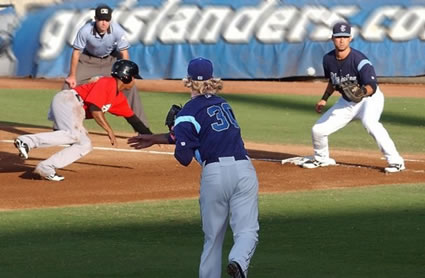|
Find out if they are bunting By: Coach Bob McCreary Provided by: Baseball By The Yard
It's the last inning and the score is tied. The lead-off batter gets on first base. If the following batter is not a good hitter, what will happen next is pretty clear cut – a sacrifice bunt. But what if the next batter is a pretty good hitter. Will he bunt or swing away? Knowing that answer will go a long way in determining what your defensive strategy will be. If he is bunting you can run any bunt play you'd like, even those that require a lot of holes to open up in the infield (ex. rotational plays). If he is swinging away you keep your infielders at double play depth. Sounds easy but unless the batter has been taught to square around very early, you're not going to know what he's up to until the pitch is thrown. Guessing what he'll do is fine unless you are the third baseman who upon charging hard on a rotation play sees the batter swing away instead. Seeing a batter take a full swing when you are about 20 feet away tends to be quite an alarming experience. Guessing has its limitations.
To combat this, there is a very simple way to find out if the batter will be bunting. Make a pickoff throw to first base. You will often see this at the major league level when the defensive team is unsure of what the batter will do. Most batters (non-pitchers) at that level are taught to wait until the pitcher starts his delivery to get into the bunting position. This delay makes it tougher for the defense to plan. However, when a quick throw to first base occurs, usually the batter will react on the pitcher's first movement by getting ready to bunt. When he does this on a pickoff attempt he tips his hand as to what he'll do. After seeing the batter's reaction to the pickoff throw, the defense can then plan accordingly on the next pitch. Defensive players should be trained to look for this. Catchers or coaches should call for a pickoff. Infielders who are not involved in the pickoff and coaches on the bench should not take their eyes off the batter in order to see his reaction. If he starts to square around, he was told to bunt. If he doesn't react at all, he's swinging away. This is a tip for the offensive team when their batter tips his hand on the bunt.
The tip is simply to give another set of signs after the pickoff throw. If the batter shows bunt on the pickoff throw to first base then the defense can set up a strategy for the bunt. The element of surprise is gone. However, if the coach flashes another set of signs after the pickoff move then the defensive team is forced to do more guessing. “Did he take the bunt sign off now that he knows that we know or did he just give the same bunt sign again to get us thinking?” Advantage offense. Of course, the cat and mouse game can continue with more pickoff throws but eventually a pitch has to be thrown.
|








